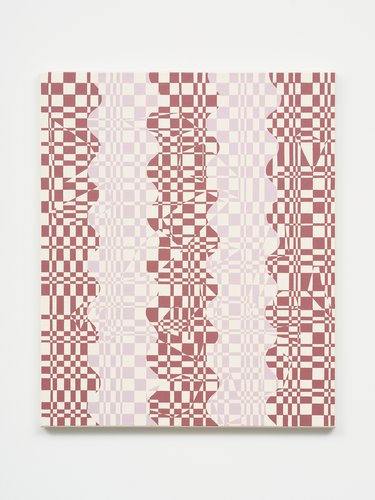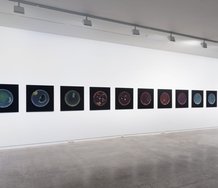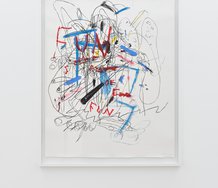John Hurrell – 17 August, 2025
In their own way these quite intimate paintings are surprisingly shocking. Especially if you take the unlikely view that the artist is tampering with well-known images that are sacred, and so mocking art history. You would then assume that earlier artists ‘own' the images they create. If so, then to later fiddlers, you might say: ‘Hands Off!'
In the artist’s gallery page explanation, the nine works here openly reference well known art historical paintings by Magritte, Manet, Morisot and Goya (and in my view, perhaps slyly a play by Genet) but convert the initially inspiring figurative source imagery of people on display into geometric abstractions that are gridded and patterned. To put it crudely, she transforms what was once haunting dreamlike (symbolic) imagery linked to the subconscious so it then becomes commonplace domestic ‘tablecloths.’ A ‘feminising’ process you might argue, that occasionally nod to a balcony’s safety barriers, but with the explanatory sequential stages left out.
In their own way these quite intimate paintings are surprisingly shocking. Especially if you take the unlikely view that the artist is tampering with well-known images that are sacred, and so mocking art history. You would then assume that earlier artists ‘own’ the images they create. If so, then to later fiddlers, you might say: ‘Hands Off!’
Of course, by meanly saying that these are ‘tablecloths’ I’m ignoring the paintings’ great attraction: their complexity and subtly emerging shifts in structure. They need time for contemplative study. Consider too that you don’t have to hang onto the artist’s every word about how they were constructed. Often art has significant qualities their creator is oblivious to, being made largely through complex ‘gut’ layers of instinct and intuition.
There could be a sensualist argument that these works are too intellectual and not sufficiently bodily. For if they ‘work’, that is an optical, not cerebral or cognitive aspect and the image’s meaning is not tightly bound to the artist’s working procedure and underpinning logic, but located somewhere else within its resulting physical impact on the viewer.
Some of Foote’s ‘abstract paintings’ render vertical iron railings on depicted balconies as a safety precaution to save soft curvy bodies from falling to gruesome deaths or injury. (Intertwined perhaps with a feminist subtext.) In others, standing or sitting voluptuous bodies are camouflaged by being hidden in flickering gridded chequerlike patterns. However I’d wager that figuring out their nineteenth century origins and subsequent transforming procedures is not an overly attractive priority. The importance of such mental/pictorial processes can be exaggerated.
John Hurrell









 Advertising in this column
Advertising in this column Two Rooms presents a program of residencies and projects
Two Rooms presents a program of residencies and projects



This Discussion has 0 comments.
Comment
Participate
Register to Participate.
Sign in
Sign in to an existing account.